
7 Artists: Richard Corben
July 7th, 2010 by david brothers | Tags: 4321, hellboy, richard corben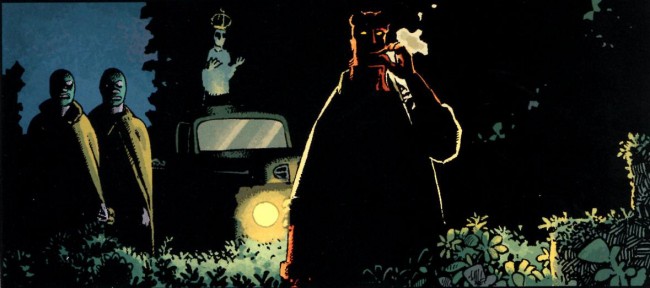
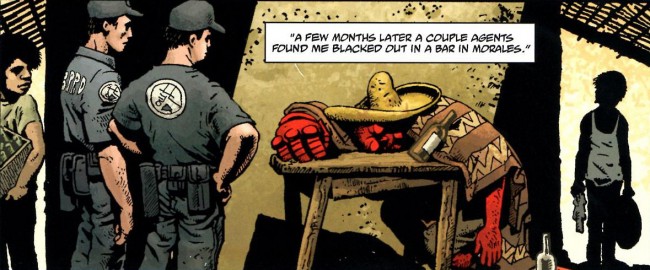
Richard Corben can draw anything. I’ve seen him do dark horror, mean crime comics, superhero books, prison drama, and post-apocalyptic ugliness with aplomb. He’s been creating stories since the late ’60s and has amassed a pretty imrpessive resume. For the past few years, he’s been working with mainstream publishers like Marvel, DC, and Dark Horse and pumping out must-read tale after must-read tale.
 The thing about Corben is that he’s not a pretty artist. His work is grotesque in the traditional sense of the word–not ugly, but distorted and unnatural. His men are super-muscular, with prominent jaws (and, when nude, penises), while his women are buxom and bulky. No one is skinny in Corben’s comics unless they’re dying or dead. Everyone’s rounded and ripped, with long or round faces, brawny arms, sausage fingers, big noses, wide lips, and thick gums. Corben exists in that weird area where his art definitely has a touch of ugly about it, but ends up being aesthetically pleasing because of that.
The thing about Corben is that he’s not a pretty artist. His work is grotesque in the traditional sense of the word–not ugly, but distorted and unnatural. His men are super-muscular, with prominent jaws (and, when nude, penises), while his women are buxom and bulky. No one is skinny in Corben’s comics unless they’re dying or dead. Everyone’s rounded and ripped, with long or round faces, brawny arms, sausage fingers, big noses, wide lips, and thick gums. Corben exists in that weird area where his art definitely has a touch of ugly about it, but ends up being aesthetically pleasing because of that.
There are a few things I think of as Corben’s signature flourishes. His approach to violence is one of them. He draws this weird, cartoony violence, like slapstick Tex Avery shorts where people actually die. In your average Corben tale, lizardmen crush skulls, axes cleave skulls in two, people get burned alive, and swords poke out eyeballs. It’s very gory, but not in a realistic way. It’s more akin to cartoon violence, where the blood and acts are exaggerated just enough to be thrilling without being too disgusting.
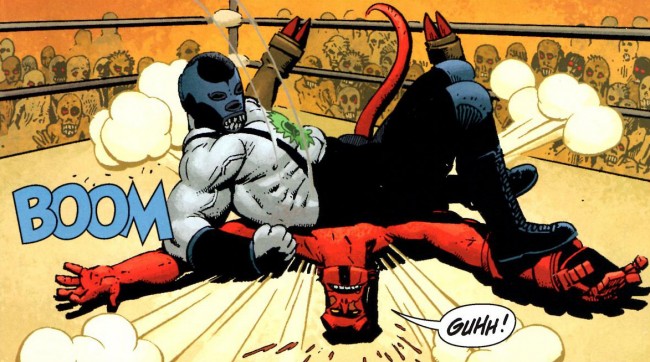
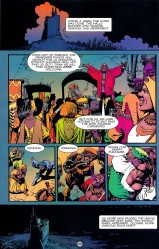
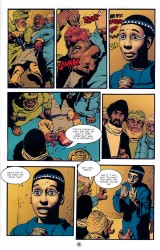
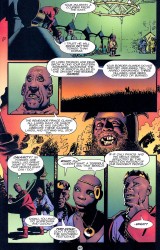
This carries on to his approach to corpses, too. They’re decayed and disgusting, with battle wounds, worms, and broken bones jutting out at odd angles, but they’re always drawn just gross enough to be interesting, rather than off-putting. His work on Hellboy, and various short stories recently, has led to Corben drawing a lot of dead people. A collaboration with John Arcudi in Solo featured Corben telling a story about the Spectre. A man is dismembered, disemboweled, and cut open, amongst other various punishments, on-panel. In the hands of a more realistic artist, say Hiroya (Gantz) Oku, you would have gotten an almost pornographically detailed vision of spewing guts and broken faces. In Corben’s hands, it’s cartoony and scary, to be sure, but you could never accuse Corben of being dependent on gore as a gross-out factor.
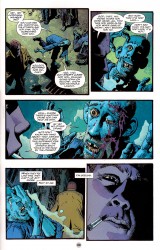
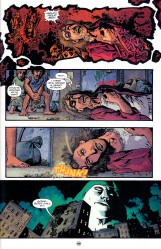
Another Corben high point is his take on Hellboy. Several artists have drawn Hellboy’s adventures, and each have had a very specific take on the character. Mike Mignola drew him as mostly monster, clearly inhuman and huge. Duncan Fegredo has a more human take on Hellboy, where he’s more of a brawny guy in a trenchcoat. Corben has the most interesting take on Hellboy for my money, though. The only way I can think to describe it is to say that it’s Hellboy by way of Sesame Street. Corben’s Hellboy looks like a muppet. He has this oddly-shaped, squared-off head, a flat jaw that’s connected to his head in a way you can’t quite figure out, and a stubby nose. If you look, really look, it looks like his jaw is connected to his head like a puppet’s jaw is connected, rather than anything that’s actually human.
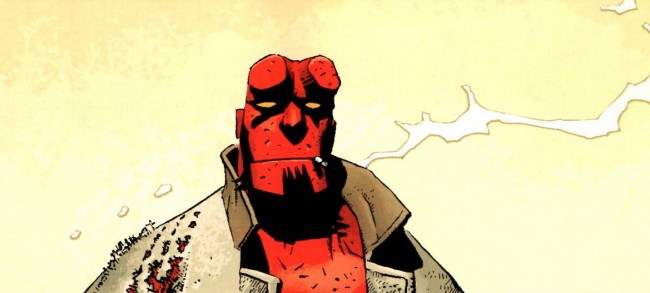
This take on Hellboy works. He looks pretty dopey in personality, but it actually adds a lot to the character. Hellboy has always been treated as a normal guy stuck in extraordinary circumstances. He doesn’t do Dr. Strange-style magic spells, and he’s just as likely to punch a monster as use a talisman to kill it. Corben’s muppet version adds a thick layer of cartooning onto Mignola’s blueprint and delivers a character that looks friendly, good-natured, and more than a little inhuman. When Hellboy is wrestling vampires or battling giant African spirits, he doesn’t feel out of place. He’s this bright spot of gritty, dirty red in the middle of a variety of browns, but it works.
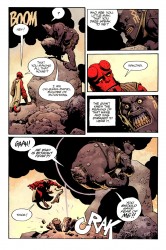
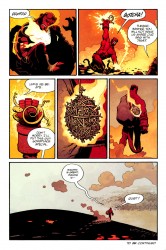
It’s creepy. His face is expressionless, with just a thick black line for a mouth, but that lack of expression makes Hellboy look kinda sad at the same time. His body is Corben-beefy, with a healthy dose of chest hair, but his head is totally out of place. Hellboy’s red right hand feels more real than Hellboy’s head does. His trenchcoat is real, but his head isn’t. The contrast between real and unreal throughout Corben’s version of Hellboy creates a weird disconnect in my mind. It actually makes it easier to buy Hellboy as taking part in these stories and whatever weirdness that comes his way. It’s spooky from jump, and all you need to know that is clear by looking at Hellboy himself.
When Frank Miller and Jim Lee were doing All-Star Batman, there was a tonal disconnect between the art and the story. Miller was doing this really hard-edged take on Batman, abrasive and maybe a little honest, and Lee’s art was more or less traditional superhero art, shiny and exuberant. I enjoyed the clash between writing and art, but it made it tough to get into the story. You have expectations that don’t get filled in the way you expect, or at all.
This otherworldly aspect of Corben’s work is what makes his work so good, I think. You’re clearly reading a story, whether it’s about a British con-man turned convict or a barbarian lost in a strange land, but it’s easy to accept that world as real and lose yourself in the story because it’s weird from the start. Due in part to his style and in part to his body of work, you may have expectations for Corben’s stories (his barbarian will find a busty lass, someone’s head will be beaten against a wall or bounced off a sidewalk, someone will light or smoke a cigarette while backlit, someone will cock their head at a wholly unnatural angle), but you don’t have just one expectation for his work.
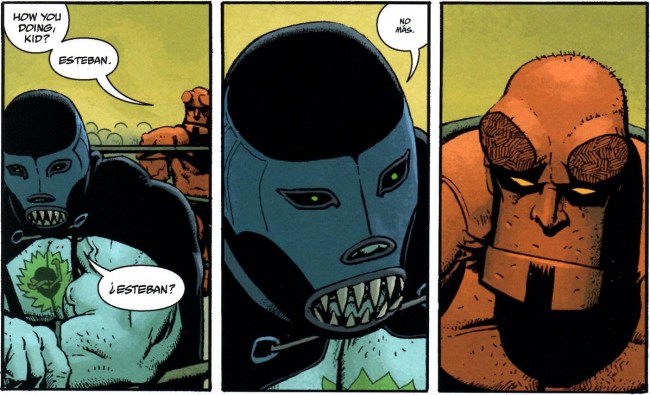
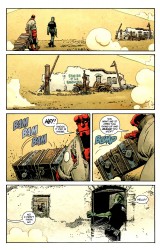
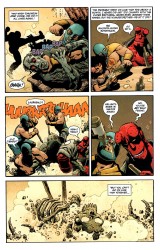
Versatility is a funny thing. The mainstream comics industry tends to place people in boxes. Jim Lee has a superhero style that evolved while he was doing X-Men with Scott Williams, but he’s also come up with a pretty fantastic watercolor style, too. What fans want, though, is his X-Men style. They want Hush, not watercolors. So, Jim Lee does big time superheroes. Michael Lark does gritty crime stuff. Amanda Conner does shiny smiley face comics. Jae Lee does moody stuff where people stand on rocks. All of them are talented and fantastic at what they do. But, when I pick up a book with their name on it, I expect to see that specific thing that they’re known for. When I pick up a Corben book, I just expect to see something that’s a little awesome, a little ugly, and a little goofy.
Corben, though, gets to skate by and do a wide variety of stories. Maybe it’s because he hasn’t been as firmly defined as capital J Jim capital L Lee in terms of what people expect, maybe it’s because his style is going to be off-model on anything but his own creations, so you’re going to get something weird no matter what it is, or maybe it’s just because he doesn’t like to do just one thing ad nauseam.
Who knows? I’m thankful for his versatility, though.
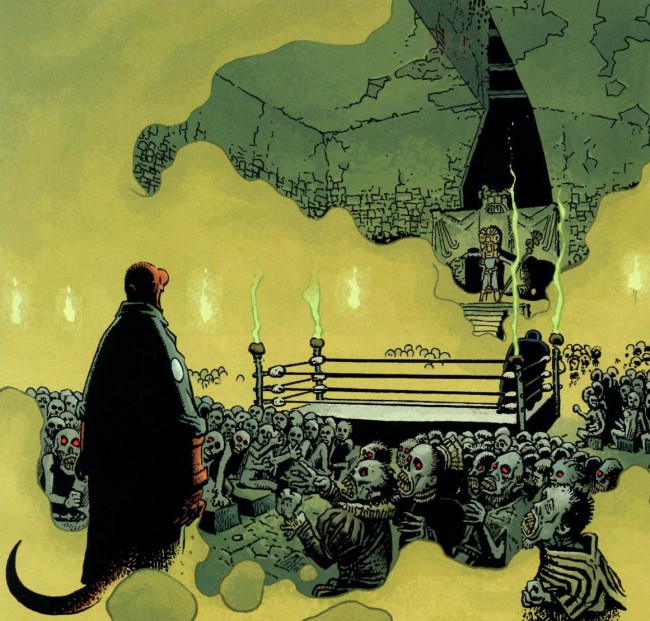

Interesting thoughts about his take on Hellboy. I do love Ron Perlman but could you imagine a Hellboy movie like Teenage Mutant Ninja Turtles? Body of some guy with a face by Jim Henson’s creature shop.
I loved his Makoma story, especially. Corben portrays Africa better than any artist I can think of.
My first exposure to Corben was him drawing Azzarello’s CAGE and I’d never seen anything like it. I’m glad that he had 30 years of previous work to go over because literally nobody draws like he does.
You haven’t read The Crooked Man yet, have you? That was Corben’s best take on Hellboy. Well, I thought so anyway.
Also recommended, if it can be found collected somewhere, his rep-making DEN, which appeared in Heavy Metal back in the 70s.
@Johnny B: I used to have the first issue of DEN: Fantastic Adventures (cover). I bought it out of a quarter bin when I was getting back into comics. (I got it, some Kirby Black Panthers, and the first issue of Starlin’s Star*Reach Classics at the same time.)
I like it, but I haven’t read… well, any of it but that one issue. I need to find that. I’d like to read the rest of it. I dug Bodyssey and… well, pretty much everything he’s touched. That Azz/Corben Hulk was pretty interesting, too.
I can see the Muppet comparison, but it looks to me more like Corben draws an action figure of Mignola’s Hellboy interacting with a Corben comic. It’s really great, whatever it is.
This is an excellent appreciation of Corben, who people seem to talk about a lot less than you’d expect considering how he’s traversed from undergrounds to alternatives to mainstream. An amazing artist. One of my top three, easily.
KS
Corben actually has built models from which to base his character drawings in the past… it wouldn’t surprise me too much to find a genuine Hellboy puppet chilling out in his studio…
@Jog: Yeah, there’s a video on his site with some footage of him drawing… I think it was from the cyclops story in Solo, the one that looked weirdly 3D because of the coloring. He definitely had a little model he was drawing from. In fact, I think I’d assumed it was CG until I saw that video recently.
I need to see this Hellboy puppet. That is a Life Goal now.
I first discoverd Corben back around 82 because this old newstand had a cardboard box full of Heavy Metal magazines that he sold me at fifty cents a pop.
I was hooked.
Niftiest place I ever had his work turn up? On the covers of the original Fighting Fantasy gamebooks.
Corben’s the first of the 7 not in my own Personal Favourites, but I’m definitely looking again.
Maybe it’s based on one he saw, but that wrestling mask is fantastic.
Hi.
I discovered Corben in my youth, in 1980 in the central color pages of Famous Monsters of Filmland the magazine. I was impressed by her drawing style, color, stories, and originality. I’ve never seen anything like it. Since then I’m a big fan of his work.
Each new story is a surprise for me. Thanks for your work master.